Woman's World
 One reason I started this blog is that I had amassed a considerable pile of books that seemed to be telling me that we are in the middle of an important artistic event in the life and history of the BOOK. We're too close to this cluster of phenomena and it's too early to suggest a schematic showing accumulated interrelationships and anyway I have come to distrust critical writing that casually connects more than two things in one move. And so the blog turns out to be the best way to put it all across, in single mouthfuls, with weeks in between. I've already written of the crisis in the field of illustration and the idea of 'authorial illustration', of picture books, who are they for?, and a playfulness with typographical novelties in the current novel here, here, and here.
One reason I started this blog is that I had amassed a considerable pile of books that seemed to be telling me that we are in the middle of an important artistic event in the life and history of the BOOK. We're too close to this cluster of phenomena and it's too early to suggest a schematic showing accumulated interrelationships and anyway I have come to distrust critical writing that casually connects more than two things in one move. And so the blog turns out to be the best way to put it all across, in single mouthfuls, with weeks in between. I've already written of the crisis in the field of illustration and the idea of 'authorial illustration', of picture books, who are they for?, and a playfulness with typographical novelties in the current novel here, here, and here.Woman's World by Graham Rawle is one of the most extraordinary books I have come across in the last couple of years. Rawle has been plowing his own furrow in the world of popular amusements for a number of years, with his various cartoon/collage series including Lost Consonants and When Words Collide. He had a book out in '98 titled Diary of an Amateur Photographer: a mystery. If we had to relate it to something else in order to describe it, we'd call up thoughts of Nick Bantock with his Griffin and Sabine series of picture books. My pal Sean MacKinnon at Bent Books has mentioned that Bantock's works are very popular with the ladies, and I can imagine that would be so, with their bright and charming sentiments. They reside in a place of the mind where the habitual fans of the graphic novel would probably not trip over them. Rawle's work is quite different. Diary has its own kind of masculine neurosis, with a grubby protagonist who passes time on his daily bus rides playing a mental game where he must have sex with every tenth woman he sees. This starts to involve considerable circumnavigation and timed closing of eyes in order to provide a pleasing result. The entire book is 'pictorial', with photos and cuttings and everything glued in and photographed. Even the typed parts of the story are typed onto to old murky papers and glued in. There is a ponderous feeling to all of it which makes approaching it an act of will. And if you are like me you will find the effort worthwhile.
You can find an interview with Rawle in the British Association of Illustrators (AOI) Journal of September 2003. This is the 'authorial issue' which I mentioned in the first link above. Lethem also mentioned Diary in The Ecstacy of Influence, his Harper's essay on Plagiarism much celebrated in this blog last week. couple of reader reviews here
 Rawle's second 'novel' takes us somehwere else entirely. It is wholly constructed from words, phrases and even paragraphs, all cut with scissors from 1960s women's magazines. The illustration at right, taken from Rawle's website, will give you the idea. The whole book is done like that, all 437 pages. It's reviewed here, by Tom Phillips, (himself an interesting figure-more on him another day), and in Eye magazine, by Rick Poynor, a key critical witer in the 'authorial illustration' movement mentioned above'. I won't talk about the plot here as it makes an interesting experience to start into it not knowing the premise let alone the plot. So if my recommendation isn't enough for you, check those reviews warily.
Rawle's second 'novel' takes us somehwere else entirely. It is wholly constructed from words, phrases and even paragraphs, all cut with scissors from 1960s women's magazines. The illustration at right, taken from Rawle's website, will give you the idea. The whole book is done like that, all 437 pages. It's reviewed here, by Tom Phillips, (himself an interesting figure-more on him another day), and in Eye magazine, by Rick Poynor, a key critical witer in the 'authorial illustration' movement mentioned above'. I won't talk about the plot here as it makes an interesting experience to start into it not knowing the premise let alone the plot. So if my recommendation isn't enough for you, check those reviews warily.Woman's World is a touching and beautiful work with psychological depth, belying its unusual origin. I would have expected from the circumstances not much more than a facetious job. You could get rid of all the cut-outs, copy the words into regular type, and it would be an impressive piece of writing. The manner of the book's composition would cast its influence as a sub text of course, since the particular words and 'found phrases' are integrated into the very substance and meaning of the work. Rawle's accomplishment is that he has written a first rate modern novel, which at its end is quite deeply moving and unforgettable.
The hardcover has 2005 date, and on its dust jacket it is described as 'a novel'. The softcover which you can see at the top of my post, tries a new gambit: Woman's World: a graphic novel. A 'graphic novel' indeed, and it was reviewed as such alongside Burns' Black Hole, Clowes' Ice Haven and the latest Acme Novelty Library from Ware in the London Times of Dec 3 2005.
If you have been following this blog since I contemplated putting "It's not a graphic novel, Percy" on a t-shirt, you'll know i have no time for arguing about labels, but I wondered who had thought that putting 'graphic novel' on the cover was the correct strategy and suspected the publisher. I introduced myself by email and asked Graham Rawle himself, who replied:
"I have no idea what the term ‘graphic novel’ means. Then why is it on my book?
Well, when the hardback came out, I wanted it to be viewed as a novel, not a novel-ty. As you know, text and image (graphic novel?) combinations tend to be lumped together with those cheap crappy Christmas books and I rather grandly wanted mine to be taken seriously. Initially I even suggested we printed it as ordinary text. For me the story was more important than the method by which it was created, but I finally decided that the two, the story and the method, were inextricably linked. It would have been daft not to show the pages. My publishers agreed and suggested it should be a traditional novel format and that we should add ‘a novel’. Just to give a clue. The result was that it got reviewed as a novel, which was good, but that browsing customers didn’t look inside to see the rip-roaringly lovely visual delight of each page. It was (my) publisher’s idea to add ‘a graphic novel’ to the paperback. They recognised they had missed out on the ‘graphic novel’ market (whatever that is), or more accurately that art bookshops, museums etc. were less inclined to stock the hardback because of the ‘a novel’ tag. I think people expect graphic novels to be comic books these days. Mine will no doubt be a disappointment to this audience because there are no drawings.
I don’t think about these labels much. I don’t know why we put ‘a novel’ and not ‘a story’. I think I suggested ‘a collaged novel’, but the publishers advised me against it. I also suggested putting some of the text scraps on the front to give some indication of what was inside. They said that would make it look less like a novel. I don’t know. I just want people to read my book. There is talk now of a film of WW. Now is that a ‘romantic comedy’ or a ‘comedy drama’? The film people want to know."
I can see this property as a movie. It wouldn't be too hard to find televisual analogues for all the quoted advertising phrases. But I can also see it ending up in American hands and the chances are they'd misunderstand the delicate beauty of it. In which case all we could hope for would be that Rawle would pocket enough dosh to go to ground for another five years (the time it took to make Woman's World) and produce another gem.
Labels: new books (1)
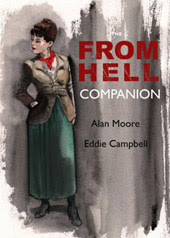
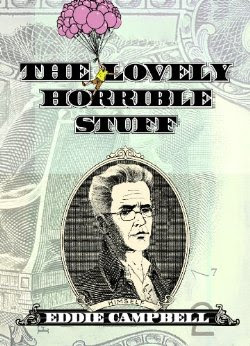

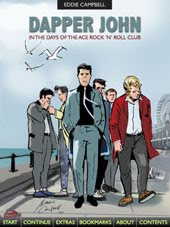
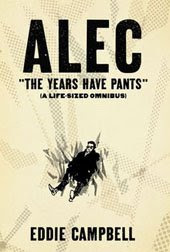
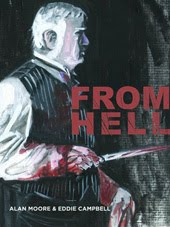
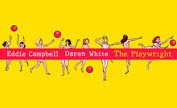
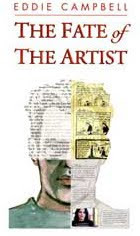

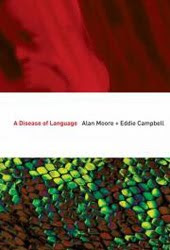
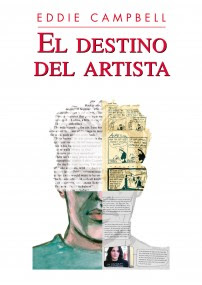
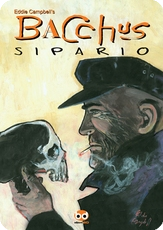
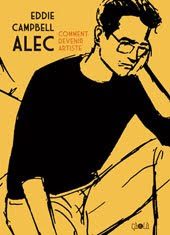

12 Comments:
That Rawle work seems very interesting, in particular if it goes a little or much in the direction of Bantock's. I am not too fond of his Sabine and Griffin work (maybe because it is charming in the same way as a Victorian scrapbook would be) but his Forgetting Room is truly beautiful.
So more books to add to the to read pile (although reading ALL the books I'd ever want to seems as feasible as trying to prove the existence of gravitational waves).
Thanks for contributing to the piling shelves overload, Eddie.
Nathalie
Please do put "It's not a graphic novel, Percy" on a t-shirt.
For anybody following this stuff from three weeks back, 'thewalker' just dropped a comment under 'Typography' and I figure no one would notice it away back there. Responding to me and John Coulthart on subject of Danielewski's House of Leaves...
thewalker said...
John: i have read in three separate interviews (ok, one is a list provided by alan) that House of Leaves is one of Alan Moores favourite books.
eddie
I am half way through Only Revolutions. and things just got a little more complex in there, beautifully so, this is a book that RELIES on the typographical "tricks". its like reading a kaleidoscope. in a good way.
I have Only Revolutions on my 'to read ' pile. No doubt you will hear from me.
Eddie
Oh, very smart, and a book I'd managed to miss. I was about to say "It looks like Tom Phillips' Humament" then you say he reviewed it, which makes perfect sense.
I didn't know Alan liked HoL but that's another addition to its credit side. I'm slowly reading my way through the complete works of Cormac McCarthy at the moment otherwise I'd start on it now.
Hi Eddie,
I read "Woman's World" last year. It's a terrific book as well as a work of art. Beautifully designed and totally absorbing.
I also highly recommend it.
A.
Although this is shallow material in comparison, has anyone read Jodi Picault? She apparently got the assignment of writing Wonder Woman based on her novel, The Tenth Circle, which has comic book enclosures in it. The concept made me curious(mainly because she was a mainstream novelist), but on a quick skim the comic pages looked so dreadful that I didn't bother to purchase a copy.
But there is the downfall of the movie. What made you truly love it that much more, would now be dead.
You're making my brain hurt.
There have been some attempts at film and TV collage works although it's a fair bet they're less successful than Graham Rawle's book. There was a decent TV attempt in 1987 called Invisible Television made from bits of old tv series like The Invisible Man (1958 version), The Prisoner, and so on.
http://ftvdb.bfi.org.uk/sift/title/418436
And if you go to Archive.org there's people there make collage works from their copyright-free films.
love to hear your thoughts on A HUMUMENT -- i recently started doing "blackout" poems, and people came out of the woodwork mentioning TOm Phillips -- i ordered the book and it is crazy
Austin
yes, i'm building up to it.
not long
eddie
ps
got it in the same package as Woman's World
Post a Comment
Subscribe to Post Comments [Atom]
<< Home